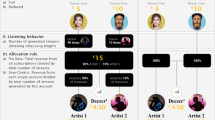Abstract
In the television show Deal or No Deal, a contestant is endowed with a sealed box containing a monetary prize between one cent and half a million euros. In the course of the show, the contestant is offered to exchange her box for another sealed box with the same distribution of possible monetary prizes inside. This offers a unique natural experiment for studying endowment effects under high monetary incentives. We find evidence of only a weak endowment effect when contestants exchange their box for another box with the same distribution of possible prizes.
Similar content being viewed by others
References
Abdellaoui M. (2000) Parameter-free elicitation of utility and probability weighting functions. Management Science 46: 1497–1512
Blavatskyy P., Pogrebna G. (2008) Risk aversion when gains are likely and unlikely: Evidence from a natural experiment with large stakes. Theory and Decision 64: 395–420
Blavatskyy, P., & Pogrebna, G. (2009). Models of stochastic choice and decision theories: Why both are important for analyzing decisions. Journal of Applied Econometrics (forthcoming)
Bombardini, M., & Trebbi, F. (2005). Risk aversion and expected utility theory: A field experiment with large and small stakes (unpublished manuscript)
Brookshire D., Coursey D. (1987) Measuring the value of a public good: An empirical comparison of elicitation procedures. American Economic Review 77: 554–566
Coursey D., Hovis J., Schulze W. (1987) The disparity between willingness to accept and willingness to pay measures of value. Quarterly Journal of Economics 102: 679–690
Charness G., Levin D. (2005) When optimal choices feel wrong: A laboratory study of Bayesian updating, complexity, and affect. American Economic Review 95: 1300–1309
Deck C., Lee J., Reyes J. (2008) Risk attitudes in large stakes gambles: Evidence from a game show. Applied Economics 40(1): 41–52
Friedman D. (1998) Monty Hall’s three doors: Construction and deconstruction of a choice anomaly. American Economic Review 88: 933–946
Kahneman D., Knetsch J.L., Thaler R.H. (1990) Experimental tests of the endowment effect and the Coase Theorem. Journal of Political Economy 98: 25–48
Kahneman D., Knetsch J., Thaler R. (1991) Anomalies: The endowment effect, loss aversion, and status quo bias. Journal of Economic Prospectives 5(1): 193–206
Kahneman D., Tversky A. (1979) Prospect theory: An analysis of decision under risk. Econometrica 47: 263–291
Knetsch J.L. (1989) The endowment effect and evidence of nonreversible indifference curves. American Economic Review 79(5): 1277–1284
Knetsch J.L., Sinden J.A. (1984) Willingness to pay and compensation demanded: Expermental evidence of an unexpected disparity in measures of value. Quarterly Journal of Economics 99(3): 507–521
Knez P., Smith V.L., Williams A. (1985) Individual rationality, market rationality, and value estimation. American Economic Review 75: 397–402
Koszegi B., Rabin M. (2006) A model of reference-dependent preferences. Quarterly Journal of Economics 121(4): 1133–1165
List J. (2004) Neoclassical theory versus prospect theory: Evidence from the marketplace. Econometrica 72(2): 615–625
Loomes G., Sugden R. (1987) Some applications of a more general form of regret theory. Journal of Economic Theory 41: 270–287
Myagkov M., Plott Ch.R. (1997) Exchange economies and loss exposure: Experiments exploring prospect theory and competitive equilibria in market environments. American Economic Review 87(5): 801–828
Plott Ch.R., Zeiler K. (2007) Exchange asymmetries incorrectly interpreted as evidence of endowment effect theory and prospect theory?. American Economic Review 97: 1449
Pogrebna G. (2008) Naive advice when half-a-million is at stake. Economics Letters 98(2): 148–154
Post T., Vanden Assem M., Baltussen G., Thaler R. (2008) Deal or no deal? Decision making under risk in a large-payoff game show. American Economic Review 98(1): 38–71
Samuelson W., Zeckhauser R. (1988) Status quo bias in decision making. Journal of Risk and Uncertainty 1(1): 7–59
Shogren J.F., Shin S.Y., Hayes D.J., Kliebenstein J.B. (1994) Resolving differences in willingness to pay and willingness to accept. American Economic Review 84: 255–270
Thaler R. (1980) Toward a positive theory of consumer choice. Journal of Economic Behavior and Organization 1: 39–60
Tversky A., Kahneman D. (1991) Loss aversion in riskless choice: A reference-dependent model. Quarterly Journal of Economics 106: 1039–1061
Tversky A., Kahneman D. (1992) Advances in prospect theory: Cumulative representation of uncertainty. Journal of Risk and Uncertainty 5: 297–323
Author information
Authors and Affiliations
Corresponding author
Additional information
Previous version of this paper was circulated under the title “Loss Aversion? Not with Half a Million on the Table!”.
Rights and permissions
About this article
Cite this article
Blavatskyy, P., Pogrebna, G. Endowment effects? “Even” with half a million on the table!. Theory Decis 68, 173–192 (2010). https://doi.org/10.1007/s11238-009-9152-4
Received:
Accepted:
Published:
Issue Date:
DOI: https://doi.org/10.1007/s11238-009-9152-4




